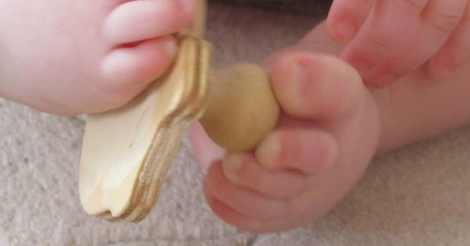
My son introduced me to the cutaneous rabbit illusion a few weeks ago. It’s a pretty interesting phenomenon. Basically the nerves in your forearm aren’t wired for strong spatial resolution, so the brain fudges a little to figure out where along your arm a given sensation originated from. As a result, some taps at your wrist and elbow can be perceived as a series of taps running up the length of your forearm, even though nothing touched the middle area.
If you think that is a little weird, this new result is downright bizarre. Apparently, we humans can be pretty bad at figuring out which of our middle three toes is being touched. Crazy, right? If we don’t know our own bodies, what do we know? Of course, we are much better at identifying our fingers, so all is not hopeless. And it probably speaks to the adaptability of our brains, which is a very useful trait. For most of us, those middle toes operate together; there’s not much call to have them function independently, so why spend brain wiring to keep them straight? It would be interesting to see if folks with strong pedal dexterity do better at toe identification.
The fact that we treat our hands and feet so differently is at least partly because we walk upright. And having the brain power to do such complicated things with our hands — playing the piano, tying knots, anything that requires each finger to do different things — means we have the brain power to do lots of other interesting things as well. Math, for one; it’s no coincidence that we use the same word, ‘digit’, for our fingers and our numbers. We are embodied creatures; we may be able to transcend our biology, but we are still intricately entwined with it. And that makes the incarnation such a fascinating element of Christian theology. We have a high priest who can sympathize with our weaknesses, including losing track of our toes sometimes.
Housekeeping: Thanks again to everyone who replied to the reader survey. The giveaway eligibility is closed, but you are still welcome to send feedback if you want. All winners have been notified at the e-mail address they submitted. Over the coming months, I will be answering the questions sent in by readers. My aim is to answer 1 per month, with some shorter posts on related topics leading up to a longer format answer. That way, you have a chance to see where I might be coming from and provide input in the comments before I wrap up a given topic.
Next week I’ll be talking about a theology of science as part of a wider ESN focus on the theology of higher education.
Andy has worn many hats in his life. He knows this is a dreadfully clichéd notion, but since it is also literally true he uses it anyway. Among his current metaphorical hats: husband of one wife, father of two teenagers, reader of science fiction and science fact, enthusiast of contemporary symphonic music, and chief science officer. Previous metaphorical hats include: comp bio postdoc, molecular biology grad student, InterVarsity chapter president (that one came with a literal hat), music store clerk, house painter, and mosquito trapper. Among his more unique literal hats: British bobby, captain’s hats (of varying levels of authenticity) of several specific vessels, a deerstalker from 221B Baker St, and a railroad engineer’s cap. His monthly Science in Review is drawn from his weekly Science Corner posts — Wednesdays, 8am (Eastern) on the Emerging Scholars Network Blog. His book Faith across the Multiverse is available from Hendrickson.

Leave a Reply